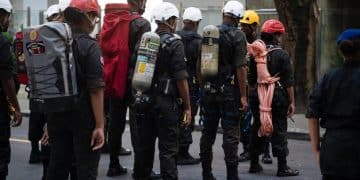Culturally Sensitive Humanitarian Aid: Best Practices for US Communities

Culturally sensitive humanitarian aid in the US involves understanding and respecting the diverse cultural backgrounds of affected communities, ensuring aid is delivered in a way that is appropriate and effective for everyone.
Providing effective humanitarian aid to diverse communities within the US requires more than just delivering resources; it demands a deep understanding and respect for cultural differences. The best practices for providing culturally sensitive humanitarian aid to diverse US communities ensure that assistance is not only effective but also respectful and empowering.
Understanding Cultural Sensitivity in Humanitarian Aid
Cultural sensitivity in humanitarian aid means recognizing and valuing the diverse cultural backgrounds within affected communities. This understanding shapes how aid is delivered, ensuring its appropriateness and effectiveness.
When aid is culturally sensitive, it addresses the specific needs of each community while respecting their traditions, values, and beliefs. This approach enhances trust and cooperation, which are crucial for successful humanitarian efforts.

What Cultural Sensitivity Entails
Cultural sensitivity involves several key elements: awareness, respect, and adaptation. It requires aid workers to be conscious of their own cultural biases and to appreciate cultural differences.
- Awareness: Recognizing one’s own cultural perspectives and biases.
- Respect: Valuing the cultural practices and beliefs of others.
- Adaptation: Tailoring aid delivery methods to fit the cultural context.
Adapting aid includes modifying communication strategies, resource distribution methods, and the types of aid provided to better align with community needs and preferences. This ensures that aid is not only practical but also culturally acceptable.
In conclusion, cultural sensitivity ensures that humanitarian aid is delivered effectively and respectfully, fostering mutual trust and cooperation between aid providers and the communities they serve.
Community Engagement and Needs Assessment
Engaging with the community and conducting thorough needs assessments are critical steps in providing culturally sensitive humanitarian aid. This ensures that the aid provided is relevant and responsive to the specific needs of the population.
Effective community engagement involves establishing open communication channels, building trust, and involving community leaders in the planning and decision-making processes. This helps aid organizations gain valuable insights into the community’s cultural norms and priorities.
Importance of Needs Assessments
Needs assessments provide a detailed understanding of the community’s challenges and resources, ensuring that aid efforts are targeted and effective. These assessments should consider the cultural context, involving community members in the process.
- Cultural Context: Understanding local customs and traditions.
- Resource Identification: Recognizing available community resources.
- Prioritization: Addressing the most urgent community needs first.
Cultural context is crucial because what might be considered a need in one community could be different in another. For instance, food preferences vary across cultures, and providing culturally appropriate food is essential for effective aid.
Therefore, community engagement and needs assessments are essential for understanding the unique needs of diverse US communities, enabling aid organizations to provide effective and culturally sensitive assistance.
Communication Strategies for Diverse Audiences
Effective communication is crucial for delivering humanitarian aid to diverse populations. Tailoring communication strategies to suit different cultural groups ensures that messages are understood and trusted.
Language barriers can significantly hinder aid delivery. Providing information in multiple languages and using interpreters helps bridge these gaps, ensuring that everyone has access to vital information. Additionally, non-verbal communication methods can be effective in conveying empathy and understanding. Consider the following:
Best Practices for Communication
To communicate effectively, consider the following practices to reach the people your aid is intended to reach.
- Multiple Languages: Translate materials into prevalent languages.
- Interpreters: Use qualified interpreters for direct communication.
- Visual Aids: Employ visual aids like diagrams and videos.
When it comes to communicating with diverse communities, understand that what one demographic responds to might differ vastly in another. The key is to be flexible, understanding that it’s not a one-size-fits-all approach.

Training and Capacity Building for Aid Workers
Training is pivotal if aid workers are to understand the best practices for providing culturally sensitive humanitarian aid to diverse US communities. It is so easy to misunderstand needs, so let’s look at capacity building.
Capacity building and cultural competency are essential in ensuring that aid workers are well-equipped to handle cross-cultural interactions. They will be able to promote understanding and respect.
Components of Effective Training
Effective training programs require significant preparation and the right participants. How should it work though?
- Cultural Awareness Workshops: Teaching about local customs and traditions.
- Language Training: Offering basic language skills for key languages.
- Sensitivity Training: Addressing biases and promoting empathy.
By empowering aid workers with the best training available, aid organizations can ensure that their teams meet the specific needs of diverse communities, ultimately leading to better outcomes and stronger relationships.
In summary, training and capacity building provide aid workers with essential skills, enabling them to deliver culturally sensitive humanitarian aid that respects and empowers diverse US communities.
Addressing Specific Cultural Needs
Recognizing and addressing the specific cultural needs of affected communities is essential for effective aid delivery. This involves understanding cultural preferences, dietary restrictions, religious practices, and other unique factors.
Tailoring aid to meet these specific needs enhances the relevance and acceptance of assistance. For instance, providing culturally appropriate food and hygiene products ensures that aid is both practical and respectful. What are other considerations?
Tailoring Aid to Specific Needs
Tailoring aid means adapting resources to align with the cultural preferences and practices of different communities. Here are some points to bear in mind:
- Food Preferences: Offering culturally appropriate food items.
- Hygiene Products: Providing products that align with cultural norms.
- Religious Considerations: Respecting religious practices and needs.
Understanding and addressing specific cultural needs is a fundamental aspect of providing effective humanitarian aid, fostering acceptance, and promoting community resilience by meeting particular community expectations.
Collaboration with Community Leaders and Organizations
In humanitarian aid, collaboration with community leaders and organizations is essential to ensure that efforts are culturally sensitive and effective. By working with local stakeholders, aid organizations can gain invaluable insights into the needs and perspectives of the community.
Community leaders serve as vital bridges, facilitating communication, building trust, and ensuring that aid aligns with local values and traditions. Additionally, local organizations play a critical role in identifying and addressing needs that external aid providers may overlook.
Strategies for Effective Collaboration
To create more effective collaborations:
- Establish Partnerships: Form partnerships with local organizations.
- Consult Leaders: Seek guidance from community leaders.
- Involve Stakeholders: Engage community members in decision-making.
By actively engaging with community leaders and organizations, aid providers can ensure that their efforts are respectful, relevant, and sustainable, fostering stronger relationships and greater community resilience.
| Key Point | Brief Description |
|---|---|
| 🤝 Community Engagement | Involve community members in planning. |
| 🗣️ Communication | Use languages and methods that resonate. |
| 👨🏫 Training | Equip aid workers with cultural knowledge. |
| 🙏 Respect | Always respect cultural norms and values. |
Frequently Asked Questions (FAQ)
▼
Cultural sensitivity ensures aid is relevant, respectful, and effective. It builds trust, promotes cooperation, and avoids unintended negative impacts by aligning aid with community values and traditions.
▼
Aid organizations can assess cultural needs through community engagement, needs assessments, and consultation with community leaders. Surveys, focus groups, and interviews help gather detailed cultural insights.
▼
Culturally sensitive communication includes using multiple languages, employing qualified interpreters, and adapting communication methods to suit local norms. Visual aids and non-verbal cues can also enhance understanding.
▼
Aid workers can be trained through cultural awareness workshops, language training, and sensitivity training. These programs help workers understand cultural contexts, address biases, and promote empathy for diverse communities.
▼
Collaboration with community leaders ensures aid aligns with local values and traditions. Community leaders provide valuable insights, facilitate communication, and build trust between aid organizations and the community.
Conclusion
In conclusion, the best practices for providing culturally sensitive humanitarian aid to diverse US communities involve understanding and respecting cultural differences and engagement with community leaders. By embracing these strategies, aid organizations can deliver more effective, respectful, and sustainable assistance, thereby promoting greater community resilience and fostering stronger relationships.





